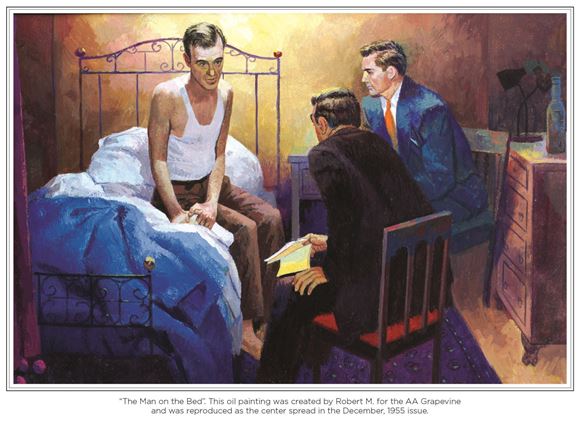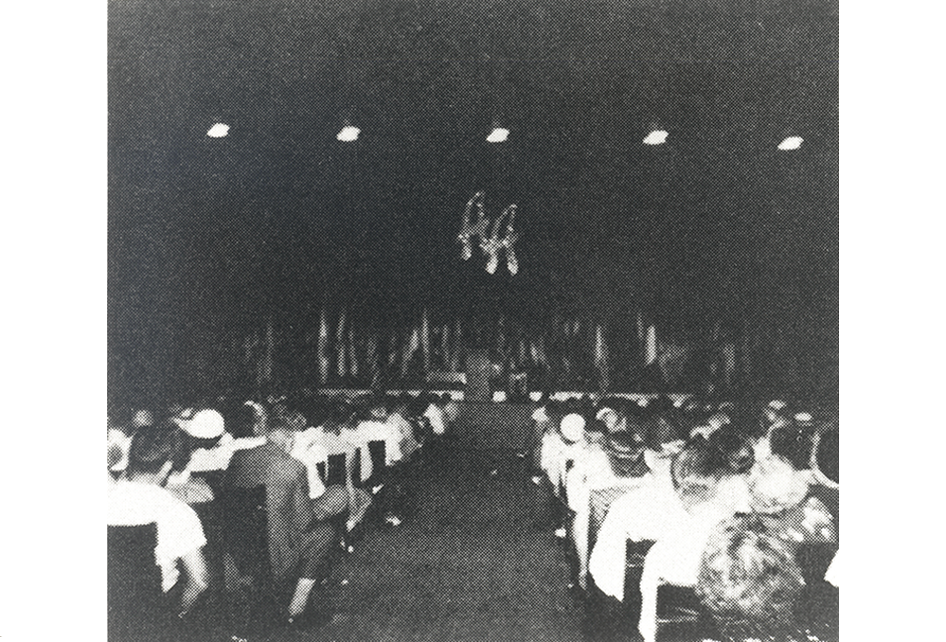The history of A.A. began in the United States, spread to Canada, and then went worldwide. A.A. presence now exists in more than 180 countries. Following is a short history about the start of A.A. and some of its key contributors.
A.A.’s Beginning
A.A. began in 1935 in Akron, Ohio, as the outcome of a meeting between Bill W., a New York stockbroker, and Dr. Bob S., an Akron surgeon. Both had been hopeless alcoholics.
Before their meeting, Bill and Dr. Bob had each been in contact with the Oxford Group. This mostly nonalcoholic fellowship emphasized universal spiritual values in daily living. The Episcopal clergyman, Dr. Samuel Shoemaker, led the Oxford Groups in the U.S. at that time.
Under this spiritual influence, and with the help of an old-time friend, Ebby T., Bill had gotten sober. Bill maintained his recovery by working with other alcoholics. Yet, before meeting Dr. Bob, none of these other alcoholics had actually recovered.
At the same time, Dr. Bob’s Oxford Group membership in Akron had not helped him enough to achieve sobriety. When Dr. Bob and Bill finally met, the effect on the doctor was immediate. This time, he found himself face-to-face with a fellow sufferer who was succeeding.
Bill emphasized that alcoholism was a malady of mind, emotions, and body. Bill learned this important fact from Dr. William D. Silkworth of Towns Hospital in New York. Bill had often been a patient of Dr. Silkworth. Though a physician, Dr. Bob had not known alcoholism to be a disease. Responding to Bill’s convincing ideas, Dr. Bob soon got sober, never to drink again. This sparked the founding of A.A.
Both men immediately set to work with alcoholics at Akron’s City Hospital. One patient quickly achieved complete sobriety. These three men made up the nucleus of the first A.A. group (though the name Alcoholics Anonymous was not yet used.)

Growth Starts Slowly, Then Expands Quickly
In the fall of 1935, a second group of alcoholics slowly took shape in New York. A third appeared at Cleveland in 1939. It took four years to produce about 100 sober alcoholics in the three founding groups.
Early in 1939, the Fellowship published its basic textbook, Alcoholics Anonymous. The text, written by Bill and reviewed by many of the early members, explained A.A.’s philosophy and methods. The core of this work is now well-known as the Twelve Steps of recovery. The book also included case histories of thirty recovered members. From this point, A.A.’s development was rapid.
Also in 1939, The Cleveland Plain Dealer published a series of articles about A.A.
These articles, accompanied by positive editorials, triggered many pleas for help in Cleveland. The Cleveland group, with only twenty members, sought to help those alcoholics. Alcoholics sober only a few weeks were set to work on brand-new cases. This was a new departure, and the results were fantastic. A few months later, Cleveland’s membership had expanded to about 500.
Meanwhile, in New York in 1938, Dr. Bob and Bill had organized a trusteeship for the budding Fellowship. Friends of John D. Rockefeller, Jr. became board members alongside a contingent of A.A.s. This board was named The Alcoholic Foundation. But all efforts to raise large sums of money failed because Mr. Rockefeller concluded that it might spoil the infant society.
Even so, the foundation managed to open a tiny office in New York. This office aimed to handle inquiries and to distribute the A.A. book. To date, these efforts had been mostly financed by the A.A.s themselves.
The book and the new office were quickly put to use. Liberty magazine published an article about A.A. in the fall of 1939, resulting in some 800 urgent calls for help. In 1940, Mr. Rockefeller gave a dinner for many of his prominent New York friends to publicize A.A.
This brought yet another flood of pleas. Each inquiry received a personal letter and a small pamphlet. Attention was also drawn to the book Alcoholics Anonymous, which soon began circulating. Aided by mail from the office and A.A. travelers from already-established centers, many new groups began. At the year’s end, the membership stood at 2,000.
Then, in March 1941, The Saturday Evening Post featured an excellent article by about A.A by Jack Alexander. The response was enormous. By the close of that year, the membership had jumped to 6,000, and the number of groups multiplied in proportion. The Fellowship spread across the U.S. and Canada.
By 1950, 100,000 recovered alcoholics could be found worldwide. Spectacular though this was, the period 1940-1950 was nonetheless one of great uncertainty. The crucial question was whether all those mercurial alcoholics could live and work together in groups. Could they hold together and function effectively? This was the unsolved problem. The New York headquarters spent much time corresponding with thousands of groups about their questions.
By 1946, however, it was possible to draw some conclusions about the kinds of attitude, practice and function that would best suit A.A.’s purpose. Those principles emerged from strenuous group experience. They were summarized by Bill in the Twelve Traditions of Alcoholics Anonymous. By 1950, the earlier chaos had largely disappeared. A successful formula for A.A. unity and functioning had been achieved and put into practice.
Co-Founder Dr. Bob’s Major Impact in Ohio
During this hectic ten-year period, Dr. Bob devoted himself to hospital care for alcoholics. He introduced them to A.A. principles. Large numbers of alcoholics flocked to Akron to receive care at St. Thomas Hospital. Dr. Bob became a member of its staff. He and the fellow staff member, the remarkable Sister Ignatia, cared for and brought A.A. to some 5,000 sufferers. After Dr. Bob’s death in 1950, Sister Ignatia continued to work at Cleveland’s Charity Hospital. She was assisted by the local A.A. groups and 10,000 more sufferers first found A.A. there. This set a fine example of hospitalization wherein A.A. could cooperate with both medicine and religion.
In this same year of 1950, A.A. held its first International Convention at Cleveland. There, Dr. Bob made his last appearance and spoke in his final talk of the need to keep A.A. simple. He saw the Twelve Traditions enthusiastically adopted for the permanent use of the A.A. Fellowship throughout the world. Dr. Bob died on November 16, 1950.

The Creation of the General Service Conference
The following year saw still another significant event. The New York office had greatly expanded its activities. These now consisted of:
- public relations
- advice to new groups
- services to hospitals
- prisons, Loners, and Internationalists
- cooperation with other agencies in the alcoholism field
The headquarters was also publishing "standard" A.A. books and pamphlets. It supervised their translation into other tongues. Our international magazine, AA Grapevine, had achieved a large circulation. These and many other activities had become indispensable for A.A. as a whole.
And yet, these vital services were still in the hands of an isolated board of trustees. The trustees’ only link to the Fellowship had been Bill and Dr. Bob. As the co-founders had foreseen years earlier, it became absolutely necessary to link A.A.’s trustees with the Fellowship that it served.
Delegates from all states and provinces of the U.S. and Canada were forthwith called in. Thus composed, this body for world service first met in 1951. Despite earlier misgivings, the gathering was a great success. For the first time, the trusteeship became directly accountable to A.A. as a whole. The A.A. General Service Conference was created, and the over-all functioning of A.A. was thereby assured for the future.
In 1955, a second International Convention in St. Louis celebrated the Fellowship’s 20th anniversary. The General Service Conference had by then completely proved its worth. Here, on behalf of A.A.’s old-timers, Bill turned the future care and custody of A.A. over to the Conference and its trustees. At this moment, the Fellowship went on its own - A.A. had come of age.
A.A. Continues Its Growth Globally
Had it not been for A.A.’s early friends, Alcoholics Anonymous might never have come into being. A.A. could never have grown and prospered without many people. Those friends of medicine, religion, and world communications were particularly essential. We have deep gratitude for their time and effort to help A.A.
On January 24, 1971, Bill died of pneumonia in Miami Beach, Florida. Seven months earlier, in the same place, he had delivered his last public words at the 35th Anniversary International Convention. His last words to his fellow A.A.s were: "God bless you and Alcoholics Anonymous forever."
Since then, A.A. has become truly global. This has revealed that A.A.’s way of life can today transcend most barriers of race, creed and language. A World Service Meeting, started in 1969, has been held biennially since 1972. Its locations alternate between New York and overseas places such as England, Mexico, New Zealand, Finland, and more.
Today, an A.A. presence can be found in approximately 180 nations worldwide. Learn more about A.A. around the world here.
See more resources to learn about A.A. history.